
Box: Hex
This one piece box with a flexible hinge comes in a variety of useful sizes and shapes. Great for storing and organizing those small items that always seem to get misplaced.
Box prints in one piece, has a folding hinge and a snap lock. For printing, the hinge needs to lay flat on the print bed. The hinge is 0.2mm thick - i.e. it’s recommended to use 0.1mm layer resolution in order to have 2 solid layers printed as a hinge. Various sizes tested in PETG on UM2 and R2x.
Visit the wiki post for an overview of all the objects available in the Library of Useful Objects.
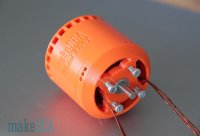
Brushless Motor
Setting itself apart from other 3D-printed motor prototypes, makeSEA’s brushless motor can be printed on most consumer-grade 3D printers and assembled by virtually anyone. It is fully functional, reliable and efficient enough for common applications like small- to mid-size RC cars. The motor features a unique ferromagnetic stator core, 40W and 90W designs, and the file notes contain comprehensive materials analysis and tooling.
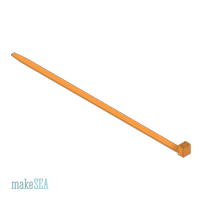
Cable Ties
More than just a cable tie. Because these versatile ties can be printed in many sizes and widths, they are suitable for many projects. Customize with color and use in the garden, workshop, office, or home!
Recommended layer height for printing is 0.2mm. Tested with PETG on UM2 and R2x. Also tested PLA, which is very brittle and not recommended for a cable tie.
Visit the wiki post for an overview of all the objects available in the Library of Useful Objects.

Flexion Hinge
It’s recommended to use a flexible material (PETG, BDP, etc.). PLA breaks too quickly. The bending part needs to be as thin as possible in order to last for a while - larger thickness will cause more stress and fail sooner. Bending thickness of stl-files is either 0.2mm or 0.3mm.
For 3d-printing select slicing layer thickness of 0.1mm or 0.15mm so the hinge has 2 thin layers at the bending part.
Visit the wiki post for an overview of all the objects available in the Library of Useful Objects.

Snap Lid for Glass Jar
Need a replacement top for those jars with missing lids? Print his replacement jar lid, available in a variety of sizes, and you've got the perfect solution. You might even want to get creative and organize your containers by lid color!
Tested with PETG and BDP. Even though PETG is said to be relative bendable, it did break sometimes in my tests. Also a problem is finding the best matching diameter - if the material is not very stretchable, the range, where the lid is working is very narrow.
Visit the wiki post for an overview of all the objects available in the Library of Useful Objects.
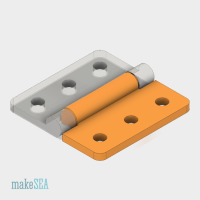
Inter-locking Hinge
This collection has a hinge solution for almost every need. The hinge prints in one piece. The two parts are interlocking (can’t be taken apart).
The gap between the two parts are by default 0.2mm. This requires accurate print settings. My R2x failed - needed 0.4mm gap because of the play of the y-axis. UM2 worked well.
Visit the wiki post for an overview of all the objects available in the Library of Useful Objects.
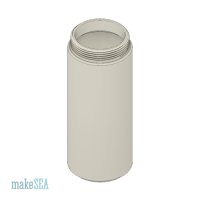
Jars
These jars come in a variety of shapes and sizes and are fully scalable. Perfect for storing and organizing small items for the kitchen, craft room, playroom or garage.
Jar Lid has a 1.5mm thread. Overhang is 60° but it prints well with PETG on UM2. Not tested on R2x. Note: even if the Jar looks well airtight, it’s not. Even water can leak out. But it certainly can keep away dust.
Visit the wiki post for an overview of all the objects available in the Library of Useful Objects.

Propellers
Print your own propellers! The pitch and diameter of these designs are adjustable and can be optimized for the geometry of the propeller and the hub can be tuned for a specific plane.
The basic version of this propeller has a 9 inch diameter and 4 inch pitch. The design allows change to both parameters and the number of blades from two to three. With 4 or more blades the hub diameter needs to increased as well. Blades and hub are separate parts.
Visit the wiki post for an overview of all the objects available in the Library of Useful Objects.
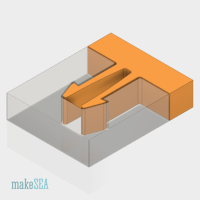
Snap: Fit Cantilever
This Snap Fit is permanently locking - basically it can’t be dismounted. By designing a small hole at the location of the hook, the hook could be bent back by pushing a small pin through the hole (an option to make it unmountable).
There is another design named “Snap Fit Cantilever B”, where the hook has a less sharp angle, which can be disassembled. The f3d-File has a parameter for the hook angle - the design is the same for both types of Snap Fit.
While the shape of this Snap Fit is quite simple, the disadvantage is the relative long length for the hole: in order to make the beams flexible enough, the length should be at minimum 8 times larger than the hook width. It also depends on the material. For printing it’s recommended to use the layering as in the images above (due to the reduced robustness along z).
Visit the wiki post for an overview of all the objects available in the Library of Useful Objects.
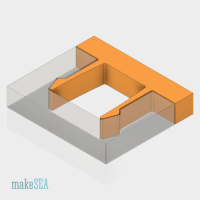
Snap: Fit Cantilever B
The Snap Fit Cantilever B is like the Snap Fit Cantilever design except the hook has a less sharp angle, so that it is not permanent and can be disassembled. Hook angle is 45°.
The f3d-File has a parameter for the hook angle - the design is the same for both types of Snap Fit. Tested with PETG, not tested with PLA.
Visit the wiki post for an overview of all the objects available in the Library of Useful Objects.
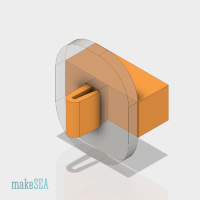
Snap: Fit Clip
Advantage: very short hole length (beam). The flexible part of the beam/hook is on the other side of the hole. Similar to the cantilever snap fit, the size of this flexible par depends on the material, and the ratio of the overall beam length compared with the hook width should also be higher than 8.
Basically this snap fit is not dismountable, but due to the sticking out flexible hook, it can be easily bent back by hand. The f3d-file has a parameter for the hook angle, by changing it to 135° it can be transformed into “snap fit clip B”. Designs are tested with PETG.
Visit the wiki post for an overview of all the objects available in the Library of Useful Objects.
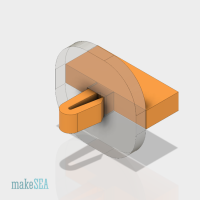
Snap: Fit Clip B
The design is not much different than the basic “Snap Fit Clip”. The slanted angle of the hook allows the clip to be dismounted by just pulling it back. The angle is a parameter in the f3d-file.
Recommended values are from 135° to 160° (depending on the required holding force and the selected material). Designs are tested with PETG.
Visit the wiki post for an overview of all the objects available in the Library of Useful Objects.

Snap: Fit Double Clip
This Double Snap Fit is basically the same as two mirrored basic clips. It has the same advantages, but in addition the two symmetrical hooks hold the mountable part more evenly. With only one hook it could dangle a bit (depending on the touching face on the other side). If the hole width is extremely large, it’s recommended to design two smaller holes (like using two mirror-inverted basic clips).
Visit the wiki post for an overview of all the objects available in the Library of Useful Objects.

Snap: Fit Clip Double B
See description of basic “Snap Fit Clip Double Clip”. Only difference is the hook angle used in order to make it dismountable. The slanted angle of the hook allows the clip to be dismounted by pulling it back.
The angle is a parameter in the f3d-file. Recommended values are from 135° to 160° (depending on the required holding force and the selected material). Designs are tested with PETG.
Visit the wiki post for an overview of all the objects available in the Library of Useful Objects.

Snap: Fit Round A
It’s a dismountable snap fit. The holding force is relatively low (depending on the hook width). This makes it useful for a door lock. The design is related to the “Snap Fit Double B” with flipped hooks pointing towards each other. The knob is the protruding middle part between two holes. If the two parts are snapped together, they can be twisted a bit like a hinge. By designing a smaller neck for the knob (or extending the cylindrical shape without neck), its rotation angle can be increased. The f3d-file has some more parameters. Tested with PETG and PLA.
Visit the wiki post for an overview of all the objects available in the Library of Useful Objects.

Snap: Fit Round B
It’s a dismountable snap fit. The holding force is relatively low (depending on the hook width). The knob is the protruding middle part between two holes. If the two parts are snapped together, they can be twisted a bit like a hinge. By designing a smaller neck for the knob (or extending the cylindrical shape without neck), its rotation angle can be increased. The f3d-file has some more parameters. Tested with PETG and PLA.
It is basically the same design as “Snap Fit Round A”, with a different orientation of the mounting plate.
Visit the wiki post for an overview of all the objects available in the Library of Useful Objects.
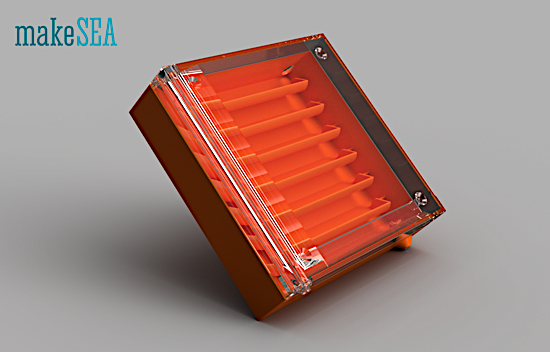
Solar Water Distiller
This project is to design a 3d printable system which can clean polluted water.
The base consists of an array of basins (black) which are filled with polluted water. The sun shines through the transparent lid and heats up the water and the air inside the box. The water evaporates, it can’t escape the box, humidity reaches 100%. Since the lid has a lower temperature (environment temperature), the vapor will condensate and build water droplets at the inside surface of the lid. The surface of the lid is tilted, and condensated water droplets are collected in a channel at the bottom edge of the lid. Read more about this project on the wiki post.

Spatula Collection A
This broad handled "spatula" is well suited for mixing, spreading and lifting of materials such as plaster and paint, but is also at home in the kitchen!
A spatula with a very basic rectangular shape. The blade front is slanted with 45°. The handle is a small extension on one edge of the blade, making the spatula more “handy”, and in particular makes the blade rigid along one dimension. Thickness can be very thin in order to make the spatula more flexible. It’s recommended to adjust the slicing diameter according the the blade thickness - it should print at minimum 4 layers. An even number of layers is also preferable, because the blade flexibility and robustness is more even. Flexibility also depends on the selected material. Tested with PETG and PLA.
Visit the wiki post for an overview of all the objects available in the Library of Useful Objects.
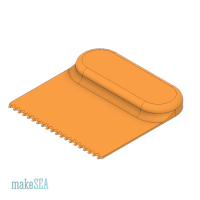
Spatula Collection A with Teeth
It’s the same design as “Spatula A“ but the blade is toothed. Useful for distributing even amounts of all kind of gels on a surface. In the model the tooth size depends on the tooth distance.
A spatula with a very basic rectangular shape. The blade front is slanted with 45°. The handle is a small extension on one edge of the blade, making the spatula more “handy”, and in particular makes the blade rigid along one dimension. Thickness can be very thin in order to make the spatula more flexible. It’s recommended to adjust the slicing diameter according the the blade thickness - it should print at minimum 4 layers. An even number of layers is also preferable, because the blade flexibility and robustness is more even. Flexibility also depends on the selected material. Tested with PETG and PLA.
Visit the wiki post for an overview of all the objects available in the Library of Useful Objects.
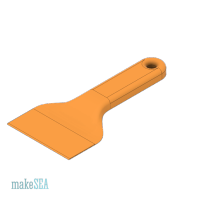
Spatula B
Call it what you will - is it a spatula, a turner, a flipper or what? Based on the more traditional spatula design, this one offers a variety of blade and handle configurations.
Same blade as “Spatula A” but with a different shaped handle. The handle in the STL files has a fixed size (60mm long, 12mm thick, 20mm width). Handle parameters and slant of blade front can be adjusted by a parameter in the f3d-file.
Visit the wiki post for an overview of all the objects available in the Library of Useful Objects.

Spatula B with Teeth
This collection mimics the B Collection but with the addition of teeth for more grip! Use it as needed to mix, spread and lift materials in the kitchen, the craft room, garage... uses are endless!
It’s the same design as “Spatula B“ but the blade is toothed. Useful for distributing even amounts of all kind of gels on a surface. In the model, the tooth size depends on the tooth distance.
Visit the wiki post for an overview of all the objects available in the Library of Useful Objects.
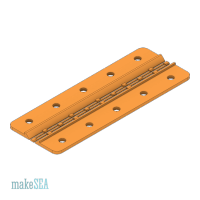
Torsion Hinge
In contrast to the flexing hinge, this hinge has thin parts, which are stressed only by torsion. The torsion bands are long enough to avaid plastic deformation.
This type of hinge should last longer than the flexible hinge. However this hinge can not carry as much load as the flexing hinge, even printed with PLA.
Visit the wiki post for an overview of all the objects available in the Library of Useful Objects.
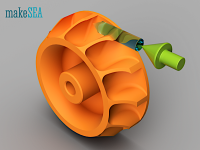
Water Turbine
This project is to build a 3d-printable water turbine re-using the brushless motor / generator design. In contrast to the wind turbine this system should produce a considerable amount of energy - not just powering a few LEDs. Water is used from a little brook, or (for testing) just tap water. I.e. water with a little bit of pressure, and relative low flow rate.
See the water turbine wiki post for more details on this ongoing project.

windpowerWriter
The goal of this project was to 3D-print a fully functional wind turbine at small scale, using commonly available printing technologies and materials. By combining the 3d printed makeSEA motor and with the exploration of other technologies, Christoph has created a piece that is so much more than just a wind turbine. The project should be inspiring and motivating for many people.
